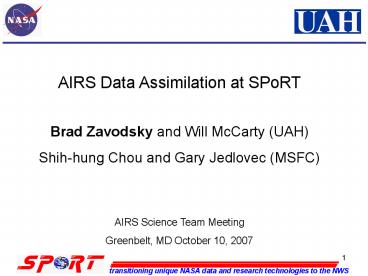AIRS Data Assimilation at SPoRT PowerPoint PPT Presentation
Title: AIRS Data Assimilation at SPoRT
1
AIRS Data Assimilation at SPoRT Brad Zavodsky
and Will McCarty (UAH) Shih-hung Chou and Gary
Jedlovec (MSFC) AIRS Science Team
Meeting Greenbelt, MD October 10, 2007
2
NASAs Short Term Prediction Research and
Transition (SPoRT) Center
- Mission Apply NASA measurement systems and
unique Earth science research to improve the
accuracy of short-term (0-24 hr) weather
prediction at the regional and local scale
(http//weather.msfc.nasa.gov/sport/) - Test-bed for rapid prototyping of new products
- Development of new products is end-user driven
- Transition research capabilities / products to
operations - real-time MODIS and GOES data and products to NWS
weather forecast offices (WFOs) and private
companies (Worldwinds, Inc., The Weather Channel) - Development of new products and capabilities for
transition - MODIS SST composites, AMSR-E rain rates, ocean
color products - AIRS Data Uses/Plans from Direct Broadcast
- L1B AIRS imagery and products
- L2 AIRS temperature and moisture profile product
- Assimilation of AIRS profiles into regional
forecast models - Direct Broadcast is vital to our success because
it provides the most timely data for our
operational end users
3
L1B Imagery and Products
- AIRS imagery and products available on the SPoRT
website in near-real-time - Images Shortwave IR, Infrared, Water Vapor,
Carbon Dioxide - Products Cloud Top Pressure, Effective Cloud
Fraction, Percent Clear Pixels - Products mostly will aid in radiance
assimilation activities
10.7 um Infrared Image
CO2 Slicing Cloud Top Pressure
Effective Cloud Fraction
4
Experiment Design
- L2 Version 5 temperature and moisture profiles
assimilated over land and water with quality
control using PBest value in each profile - Eastern and central CONUS swathes combined into
one swath assimilation time is mean of the two
overpasses - Only night time overpasses used
- 12-km WRF initialized at 0000 UTC on each
forecast date using 40-km ETA/NAM ADAS to
assimilate profiles
- Results of the 33 days of model runs are
validated using sensible weather parameters
compared to observations - Temperature and mixing ratio verified with 50
radiosondes east of 105oW - 6-hr cumulative precipitation verified with NCEP
Stage IV data east of 105oW mapped to WRF grid
5
Results 36 Hour Forecast Impact
- AIRS reduces temperature bias at most levels by
0.3oC in lower and upper levels - AIRS changes low and mid-level moisture by as
much as 5 at some levels - Temperature and moisture adjustments made
without large increases to RMS error
6
Outline
- Motivation Use of AIRS measurements within a
data assimilation system can potentially provide
better atmospheric representationparticularly
over data void regionsand improve short-term
weather forecasts - SPoRT AIRS Assimilation focuses on short-term
regional forecastscompliments work at JCSDA - Profile Assimilation (B. Zavodsky)
- Motivation and review of previous work
- Design of experiment for month-long statistics
- Results from month-long statistics
- Direct Radiance Assimilation (W. McCarty)
- Channel selection and assimilation cycle
- Results of case study
- SPoRT AIRS DA work presented Sept. 24 and 25 at
EUMETSAT/AMS Satellite Conference in Amsterdam,
The Netherlands
7
Radiance Assimilation Introduction
- In the NCEP Global Data Assimilation System
(GDAS), AIRS has already been shown to have a
significant impact in both northern and southern
hemisphere global forecasts (Le Marshall et al.
2006) - Previous work focused on preparation of AIRS
radiances for data assimilation - CO2 Sorting Technique can detect clouds and
determine uncontaminated channels in
hyperspectral data to increase the number of
usable channels over a masking approach - The proper use and assessment of these
measurements within a regional systemsuch as the
North American Model (NAM) Data Assimilation
System (NDAS)has yet to be fully assessed - Considerations of the proper utilization of AIRS
data within the pseudo-operational NDAS
environment and a preliminary look at their
impact are investigated herein
8
Channel Selection for Regional Assimilation
- Operationally, NCEP GFS uses 151 channels of the
281 channel subset - Limitations to using a regional model
- lower Ptop (2 hPa red line)
- O3 not used in regional model
- no shortwave (
- Plots show profile normalized Jacobians of each
constituent - Green hashes denote 151 GDAS channels
- Red hashes denote 103 regional channels
- No additional channels in regional subset that
are not used in global analysis
T
q
O3
9
Assimilation Cycle
- All NCEP operational observations are
assimilated every 3 hours ( 1.5 hrs) for the
CNTL runs AIRS radiances are the only difference
between NOAIRS and AIRS runs - A two-week spin-up period to propogate the
impact of the AIRS measurements through the
analysis and allow bias corrections to stabilize - Gridpoint Statistical Interpolation (GSI) and
the Weather Research and Forecasting
Nonhydrostatic Mesoscale Model (WRF-NMM) used as
analysis and model systems
10
Initial Results
- 48-hr forecast valid at 0000 UTC on 11 April
2007 - 500 hPa height anomalies for control (NOAIRS
blue) and controlAIRS (AIRS red) corresponding
NDAS analysis in black - Solid contours correspond to troughs dashed
contours correspond to ridges
B
A
Analysis AIRS NOAIRS
- A model domain (dashed lines)
- B analysis characterisized by conventional obs
(solid lines) - Both height anomaly correlation (R) and standard
deviation (s) show significant improvement
throughout the troposphere
11
Summary
- SPoRT AIRS Assimilation focuses on short-term
regional forecastscompliments work at JCSDA - Profile Assimilation Conclusions
- Results from month-long statistics
- Near-Real-Time (NRT) assimilation plans
- Direct Radiance Assimilation Conclusions
- Limitations in use of AIRS radiances in regional
NDAS reduced the number of usable channels by 17
relative to the 181 subset but still retained 37
of the channels overall - An initial case study shows statistically
significant forecast improvement throughout the
entire model domain due to the assimilation of
AIRS data - SPoRT AIRS DA work presented Sept. 24 and 25 at
EUMETSAT/AMS Satellite Conference in Amsterdam,
The Netherlands
12
Questions? Suggestions? Comments?

